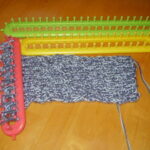Introduction
I wrote this book because I love to weave, but I don’t have the energy or the room for big and fancy looms. So I read a lot of books about off-loom weaving, and I experimented a lot, and I came up with the method I’ve written about here.
I owe a tremendous debt to the fiber artists of Hippiedom. These folks stretched the well-honored traditions of fiber work and developed methods of working that were basic and easy and great fun. I never would have considered weaving if I hadn’t seen their splendiferous work in the books and magazines of that period.
The cardboard loom I use is as basic as I can get. I also use one commercial loom quite a bit, the Peg Loom from Harrisville which is made for children 5-7 years old. It’s just perfect for me, small (6″x9″) and compact and very easy to use. You can find this loom at most good toy stores or order it from most of the mail order companies that sell weaving supplies. You’ll find the mail order companies advertised in the weaving magazines – I love looking through the ads, not only because I often find things I can’t get locally, but because I also get ideas from just looking.
I hope you’ll find the satisfaction and enjoyment in weaving that have enriched my life. Most of all, I hope you’ll have fun.
The Basics
You need to know only two words to weave: warp and weft. The warp is the vertical threads that form the backbone of the weaving. The weft is the horizontal threads that you weave in over and under.
I use the most basic weave, called plain or tabby weave. It is the over-one-and-under-one that you may have used weaving potholders or darning.
That’s it! I told you this would be really, truly easy!
Making Your Loom
The easiest way to make a loom is to use a piece of sturdy cardboard. I use the back of paper pads. Tear the back off and clean off the top so there isn’t any left-over glue. I find it easier to work vertically, so this time around you’ll be using the cardboard with the short ends at the top and bottom.
Get a ruler, hold it near to the top edge, and leave 1/2″ at the end. Then mark every l/4″ until you get to the other end, and leave another 1/2″. Do the same thing at the bottom. Don’t worry about making your marks absolutely precise – yarn is very forgiving and being a little off here and there won’t matter.
Now you’re going to cut slits where you have made your marks. If you want your slits to be even, draw a line across the top and bottom, 1/4″ from the edge. I don’t do this, but you may be more particular than I am. If you’re using decent cardboard, it will be too thick to cut with the tips of your scissors. Trty using the deepest part of the blades, or if that doesn’t work, use a utility knife. Take your time cutting the slits, but – again – don’t worry if they’re slightly off.
Now you’ve made your loom. Pretty easy, eh?
A Word About Frustration
Some people are better with their hands than others, and some, like me, have days when their coordination is less than thrilling. Also, though I think I’ve written very clear instructions, you may not agree.
So, don’t give up. Chances are you’ll have some problems here and there – I know I certainly did – but weaving is so much fun that I didn’t let my frustrations stop me.
One last thing – I’m right-handed, so I like to start working on the left side of my loom. If you’re left-handed, chances are you’ll find it easier to work from the right, so just alter my instructions to suit yourself.
Warping Your Loom
First, let’s talk about yarn. I use all sorts of yarn, but I always enjoy the cheap, wiry acrylics. Not only are they inexpensive, but they come in all sorts of brazen colors and are sturdy and slightly elastic. This time around, you want to use a medium-sized (worsted weight) yarn that’s fairly sturdy and not fuzzy. Wool would do nicely, but if you’re just trying this out, why not go the cheap route?
Warping is amazingly easy. Take the end of your yarn and put it into the upper, left-hand slot, leaving the end of an inch or two facing you. You’re going to warp starting in the back so you’ll have enough yarn for the fringe. Wrap the yarn firmly around the back and insert it into the first left-hand slot on the bottom. Then bring it up the front, again with a firm tension, and slide it into the same first slot that you put the end in. Keep wrapping the yarn firmly around the cardboard, placing it in each slot as you go. When you finish, turn the cardboard over and cut the yarn more than half-way down the loom – you’re doing this so you’ll have enough yarn for the fringe. Then tuck the end into some of the warp yarns to keep it safe and out of your way.
Finally, turn the cardboard back to the front and gently bend each end towards you. The key word is gently. You’re not trying to fold the board in half, but to create a little concave curve, which will make weaving easier.
That’s it! You have now successfully warped your loom!
Weaving
Now you’re just about read to begin. But first a word about supplies. You’ll need a pair of scissors that cuts yarn easily. You’ll also need a needle or two. Right now my favorite needle is a plastic one with a large eye that I found in the knitting section of a craft store. I also use metal tapestry needles, the large ones found in the knitting or plastic canvas sections, for thinner yarns. Be sure the needles are large enough so you can thread the yarn without shredding it.
Speaking of yarn…since this is your first weaving, you can use what you have around your home or, again, buy some cheap acrylics. The point is to experiment and see if you like weaving. If you do, you can invest in a wider range of yarns. I find it easiest to work in stripes, and for starting out, I think you will, too. So get 3 or 4 different colors that you think will work out well together.
Finally, a few words about ends. If you decide to become a serious weaver (I put myself in the slightly frivolous class), you’ll need to find a way to work in the ends of your weft yarns. I find it easiest to leave the ends on the front, because shoving them between the weaving and the cardboard is a major pain. I’ve also recently started making the ends part of my weaving design, so I use nice, long ends that create a lively, fringe effect.
O.K. Now you’re ready to begin. Cut of a piece of yarn about three times the width of your loom and thread it into the needle. Weavers usually work from the bottom up, because that makes it easier to pack down the yarn. So you’re going to start from the lower left corner. Count five warp threads into the loom and weave from right to left about an inch from the bottom. Start by going under, then over, then under then over, then under.
Congratulations! You’ve just woven in your starting end.
The object in plain weave, which is what you’re doing, is to alternate over and under on each row. Since you ended your row by going under, you’re going to start your next row by going over. But because you just wove in your starting end, you are going to start your next row below that row. So start going over and under and over and under until you reach the right end of your loom. Smoosh the yarn down to the bottom with your fingers and weave back to the left. You’ll notice that the last five under-and-overs will match the start end. Don’t worry about it – it’s at the bottom and no one will notice.
Now all you have to do is keep weaving until you’re finished, smooshing down each row as you weave it. When you reach the end of a piece of yarn, stop with an under and leave the end on the top. Start the next piece in the same place you stopped, with the under, and keep on weaving.
I’ve found that it’s too hard to weave in the last rows near the top – it’s tight and I don’t get good tension. So when I’m about half-way up the weaving, I turn my loom around and start with the top as the bottom. That way the tight rows come in the middle of the weaving, and they’re much easier to work. You do have to do a little thinking ahead, but since you’re weaving stripes, you’ll be able to figure things out.
That’s it! You’re weaving!
Finishing Your Weaving
You’ve finished your first weaving. Congratulate yourself. Dance to your favorite piece of music. Write “I am a weaver” in every different pen and pencil you have.
Now comes finishing. You’re going to use the yarn on the back of your loom to make fringe. Turn your loom over and cut the yarn in the center. I just guestimate, but if you’re nervous, measure and mark the center.
Now turn your loom over to the front. You’re going to have a loose end where you started, and the last fringe will be too long, but you can trim that when you’re done. Hold the loom so that the slits and fringe are on your right and left. Beginning in the upper left-hand corner, gently life up the top two fringes and tie them together with an overhand knot (the kind you put at the end of sewing thread) as close to the weaving as you can get it. Don’t worry if you don’t get close enough right away – just untie the knot, using a needle to loosen it, and try again. Keep doing this down the side, knotting two fringes at a time. When you get near to the bottom, if you have 5 fringes left, tie three together and then two.
Do the same thing to the other side.
That’s it. Your weaving is finished. Are you a genius or what?!?
What Now?
You are now officially a weaver.
But what happens next?
I think of my weavings as yarn sketches. I like to play with color and texture and see what turns out. I call all my weavings experiments, because I don’t do much planning ahead of time, except to choose the yarns I want to work with. Even then, I often change my mind and add and subtract as the work progresses.
You may feel otherwise. You may want to make useful things, learn how to form a variety of weaves, try some tapestry techniques, make huge wall hangings – just about anything is possible.
So, go to your library. I especially like the weaving books in the children’s department, because the directions are usually very clear. But don’t skip the adult books, because they’ll have some wonderfully inspiring pictures and lead you in more sophisticated directions. And don’t go just to the weaving books – I love looking at all sorts of fiber books. And the art books – oooh, the art books! Georgia O’Keeffe’s watercolor, “Pink and Green Mountain,” has been the inspiration for a number of my fiber pieces.
And then there are bookstores and mail order companies and used bookstores and museum exhibitions and fiber guilds and craft fairs and…
I’ve found weaving to be a never-ending source of fun and satisfaction and excitement, and it has led me into all sorts of areas I’d never thought about before. I’ve joined computer lists about fiber, written on computer talk pages, joined guilds and other fiber groups, read books and magazines, and seen live fiber pieces that I didn’t even know about a few years ago.
If you enjoyed making your first loom and weaving, you have a wondrous and thrilling time ahead of you.




